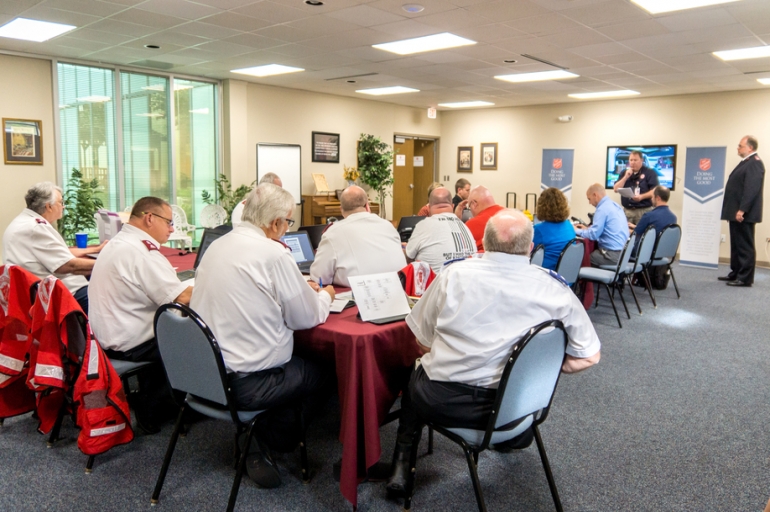Carolinas Incident Management Team Gathers for Hurricane Matthew Preparation
Shelley Henderson | shelley.henderson@uss.salvationarmy.org | (704) 621-6106

Charlotte, N.C. (October 6, 2016)--Today, the Incident Management Team (IMT) met at The Salvation Army Carolinas Divisional Headquarters, where planning and preparations continue for Hurricane Matthew. As the storm has been developing we have been coordinating virtually, sharing situational awareness electronically and by conference calls. Today the team assembled to continue to coordinate support efforts for local Salvation Army response.
In a disaster, the Salvation Army partners with community agencies and emergency management to provide meals, drinks and spiritual and emotional care to first responders and disaster survivors. The Incident Command Team includes separate functions to support service delivery.
Members of the Incident Command System include:
- Liaisons for the State EOC operations who help keep information flowing from the state to The Salvation Army so we can coordinate services and requests.
- Emotional and Spiritual Care (ESC) officer who coordinates teams of specially trained individuals that offer emotional and spiritual care to disaster survivors.
- Canteen (Mobile Feeding Kitchen) Coordinator coordinates the support for Salvation Army canteen operations and allocation of resources.
- Social Services Coordinator who coordinates the recovery, both short and long-term, to provide emergency assistance to assess survivors most urgent needs for food, clothing, and shelter.
- Logistics Section Chief who is responsible for obtaining and managing all resources and equipment necessary to support a disaster operation.
- Safety Officer identifying potential safety hazards on a disaster operation and recommending corrective actions. The Safety Officer ensures all personnel, facilities and equipment are safe.
- Finance and Administration Chief who is responsible for managing the administrative details and financial recordkeeping necessary to support a disaster operation in three main areas: personnel, statistics, and finances.
- The Public Information Officer, responsible for communicating critical information about The Salvation Army’s disaster relief activities to internal and external audiences, including the media, the general public, and other Salvation Army units.
- The team leader is the Incident Commander.
Each function works together to serve those who are most vulnerable after a disaster.
Tomorrow we will continue to monitor the storm and relocate as necessary following the impacts of the storm. We are The Salvation Army. We are here, we are ready to serve, and will be here as long as we are needed.
About The Salvation ArmyThe Salvation Army annually helps more than 30 million Americans overcome poverty, addiction, and economic hardships through a range of social services. By providing food for the hungry, emergency relief for disaster survivors, rehabilitation for those suffering from drug and alcohol abuse, and clothing and shelter for people in need, The Salvation Army is doing the most good at 7,600 centers of operation around the country. In the first-ever listing of “America’s Favorite Charities” by The Chronicle of Philanthropy, The Salvation Army ranked as the country’s largest privately funded, direct-service nonprofit. For more information, visit www.SalvationArmyUSA.org. Follow us on Twitter @SalvationArmyUS and #DoingTheMostGood.